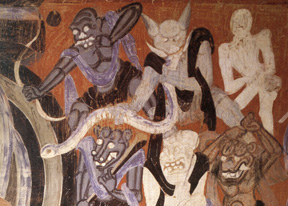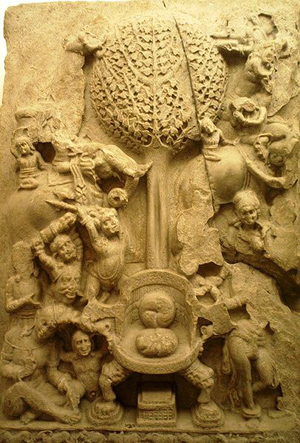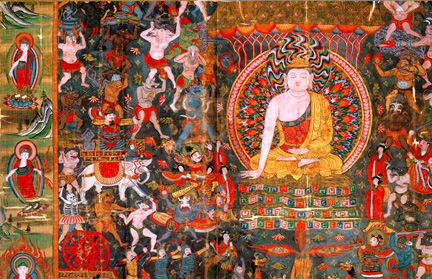In Buddhist literature we are often exposed to Mara, the sometimes wily, sometimes violent, sometimes beguiling tempter of Gautama on his way to Buddha-hood. Mara can be said to provide, essentially, a personification of that force which counters the evolutionary urge to enlightenment; it represents the energy of enslavement that undermines the quest for liberation.
Reflections on breaking the cycle of abusive relationships
 In Buddhist literature we are often exposed to Mara, the sometimes wily, sometimes violent, sometimes beguiling tempter of Gautama on his way to Buddha-hood. Mara can be said to provide, essentially, a personification of that force which counters the evolutionary urge to enlightenment; it represents the energy of enslavement that undermines the quest for liberation.
In Buddhist literature we are often exposed to Mara, the sometimes wily, sometimes violent, sometimes beguiling tempter of Gautama on his way to Buddha-hood. Mara can be said to provide, essentially, a personification of that force which counters the evolutionary urge to enlightenment; it represents the energy of enslavement that undermines the quest for liberation.
As we reflect upon that perspective, one can see Mara as virtually synonymous with samsara itself.
The nature of samsara is to maintain the illusion of reality, as conditioned through the snares of fear, promise, gain and loss. Fearful of pain, we search for the promise of happiness. Mara artfully wields carrot and stick to convince us that the pain can be avoided, the happiness can be won.
Donning this samsaric face of fear and aversion, Mara uses the desperation of the sufferer as leverage, as lure, to lead one deeper into the mire. How easy it is to tell one who is suffering that the antidote to loneliness is companionship; that the panacea to poverty is riches; that the response to existential questions are philosophical answers. And ultimately, that the only recourse to continual failure is a new and better way to achieve success.
Fundamental to the Buddhist message is a confrontation with the First Noble Truth, the truth of suffering. To suffer truly is to hit that evolutionary point where all can be gained, but where it seems, equally, all can be lost. In this place, Mara thunders and overwhelms, while the Buddha sits in silent patience. Samsara confuses and confounds, promising and denying, while nirvana seems so very far away.
Perhaps the only way to know one is truly on the path to enlightenment is when one has wrestled with the inescapable truth of suffering, and has learned to embrace it. Not masochistically, as yet another "satisfaction", but as in the condition of acceptance where one can be open to the possibility that everything was a dream - or a nightmare. That all the promises are lies, that all the pains are misunderstandings, that all the love, all the loneliness, all the hopes and fears, were things somehow ultimately - or, more accurately, relatively -unreal.
Samsara is the ghost in this fog. Mara is an abuser.
 The nature of our unenlightened life, however, is to be blind to this. This abuser we see as lover, as friend, as parent, as devoted companion. Why do we do this? Sometimes it seems, from the cold cerebral distance of pseudo-wisdom, that it is obvious the world does not keep its promises; we see, daily, reports across our media of those rich and famous, seemingly fulfilled and loved by "perfect" partners, resorting to suicide, addiction and abuse. Had we the happy convenience of being removed from the same morass, we might easily see that the solutions samsara offers are hardly solutions at all. We might all sagely nod at truisms such as "money doesn't buy happiness," yet by and large we move in this world as if it does.
The nature of our unenlightened life, however, is to be blind to this. This abuser we see as lover, as friend, as parent, as devoted companion. Why do we do this? Sometimes it seems, from the cold cerebral distance of pseudo-wisdom, that it is obvious the world does not keep its promises; we see, daily, reports across our media of those rich and famous, seemingly fulfilled and loved by "perfect" partners, resorting to suicide, addiction and abuse. Had we the happy convenience of being removed from the same morass, we might easily see that the solutions samsara offers are hardly solutions at all. We might all sagely nod at truisms such as "money doesn't buy happiness," yet by and large we move in this world as if it does.
So what is the lure? By what mechanism does it work, and fool us again and again into the same abusive relationship?
Perhaps there is some insight to be gained by looking at the inherent nature of abusive relationships themselves. In 1979 researcher Dr. Lenore Walker posited a model of domestic violence and abuse which has become something of a template in the field and is commonly referred to as "the cycle of violence." Even this name can be seen to evoke the concept of the cycle of samsara, the wheel of birth and rebirth. In the following description of this cycle, as it is typically described in relation to the concept of domestic violence within relationships, I invite you to consider the similarity with the nature of our relationship with Mara. Also consider that one of the most valuable aspects of this theory is that it points to some of the underlying reasons why those abused typically return to, and forgive, the abuser.
The cycle (imagine it as a circular loop) consists of the "build up" phase, the "stand over" phase, the "explosion" phase, the "remorse" phase, the "pursuit" phase, and the "honeymoon" phase: at the conclusion of which the cycle typically recommences.
In the "build up" phase, there is the recognition of tension. Life does not seem as perfect as it could be. There are problems, and dissatisfactions.
In this light, consider samsara.
In the "stand over" phase, the abuser starts to threaten, explicitly or implicitly, dire consequences for the victim should they not bow to their demands. If the victim does not behave "as they should" then they must confront the fear of consequences.
In this light, consider samsara.
In the "explosion" phase, the whole edifice of the relationship collapses as the truth of the dynamic between abuser and victim becomes realized. Of all the promise and expectation of love and support, all that remains is the naked fear and horror of knowing the truth. This relationship is abusive, and there is no love. Violence and complete control dominate this stage.
Again, consider samsara.
In the wake of the brutal exposure of the lie that this relationship truly is, the abuser demonstrates the behavior typical of the "remorse" phase. The abuser retreats, the abuse stops. In a natural need to regain personal power and control, the abused typically wonders what they did to cause the abuse, and perhaps what they have done for the abuse to stop. The abuser extends an olive-branch and expresses remorse, though typically with a caveat or inference that the abuser was not to blame.
Consider samsara.
In the "pursuit" phase the abuser backtracks, and realizes what may have been lost. At this point, the abuser recognizes there is work to do to ensure the abused does not leave. This is where the chocolates and roses, the demonstrations of love and affection, are poured out in abundance. The abused, reeling from the unbearable truth of what has occurred, is most vulnerable to believing it was all a mistake, or it was perhaps all their own fault, or even that it didn't happen at all. The abuser is successful in the pursuit because the abused finds it so very difficult to believe that the promise could be so heinously dashed, and the lover could so destroy the love. All that is required to make things right again is to rationalize, and to pick up the pieces and start again ...
Consider samsara.
The "honeymoon" phase is where the abused and abuser cling to each other, mutual disaster averted, and the future again full of promise. Love does indeed exist, the abused believes. Has to believe. "Togetherness" is real, and they share it. Victims of abuse typically say that the love they felt at this stage of their relationship was the best and most intense love they ever felt. The past is forgotten, denied or minimised. All that remains is two people who have shared the intensity of the low and now have the "redemption" of the high. The abused has stared down horror and has found love, and all that was required was to believe the promise. The same promise ...
Consider samsara. Consider Mara.
And after the honeymoon phase comes, again, the build-up ...
So reflect deeply on the lure, the promise, of samsara. But consider too the message of the Buddha, the "awakened." Although there is the truth of suffering, there is also the truth of the cessation of suffering. There is truly a path out of suffering. It is precisely at that point of suffering, that we might call the "explosion" phase in our relationship with Mara, that we have the opportunity to break the cycle. We have the opportunity to recognize the pursuit phase, and to see it clearly for what it is. It is simply the next chapter in the spiral.
Amitofo!

May all beings be happy
May all beings be free from suffering
Fa Gong Shakya
March 2011
